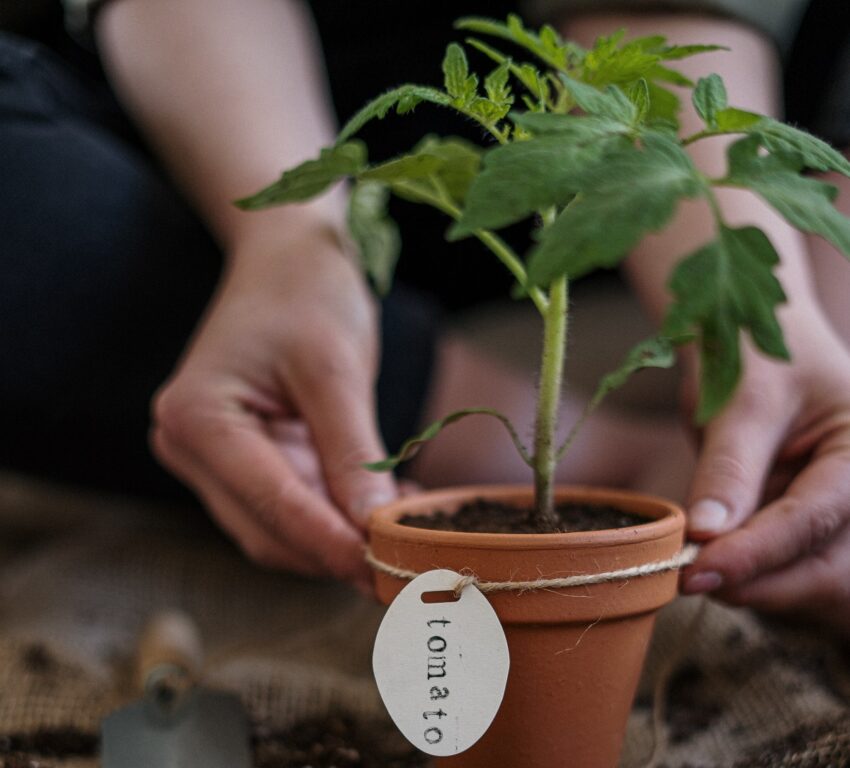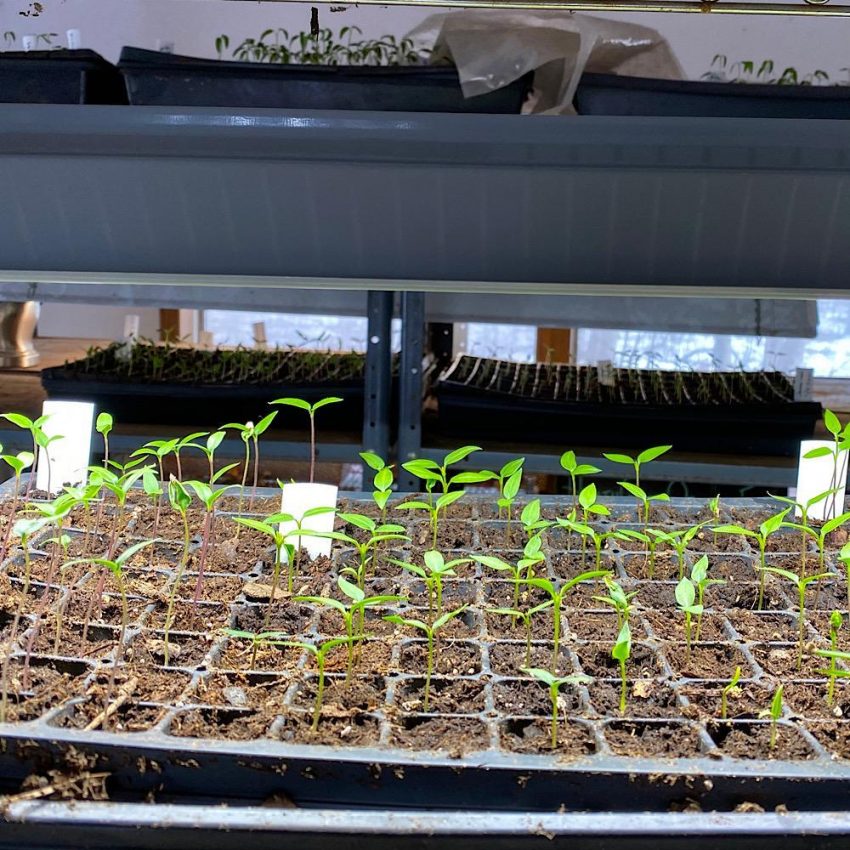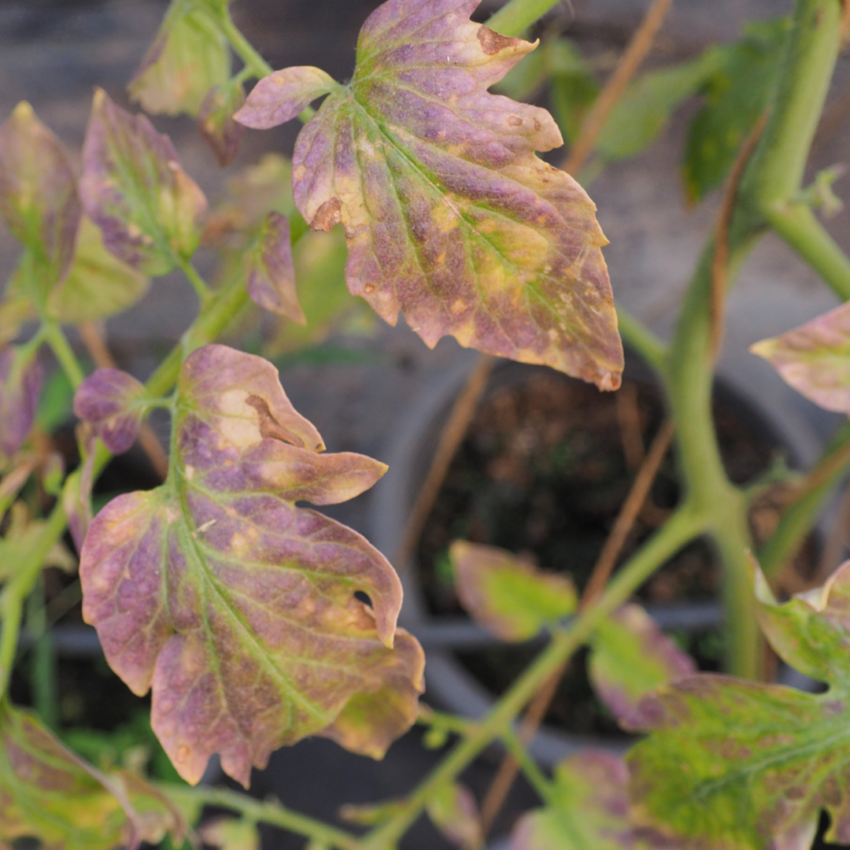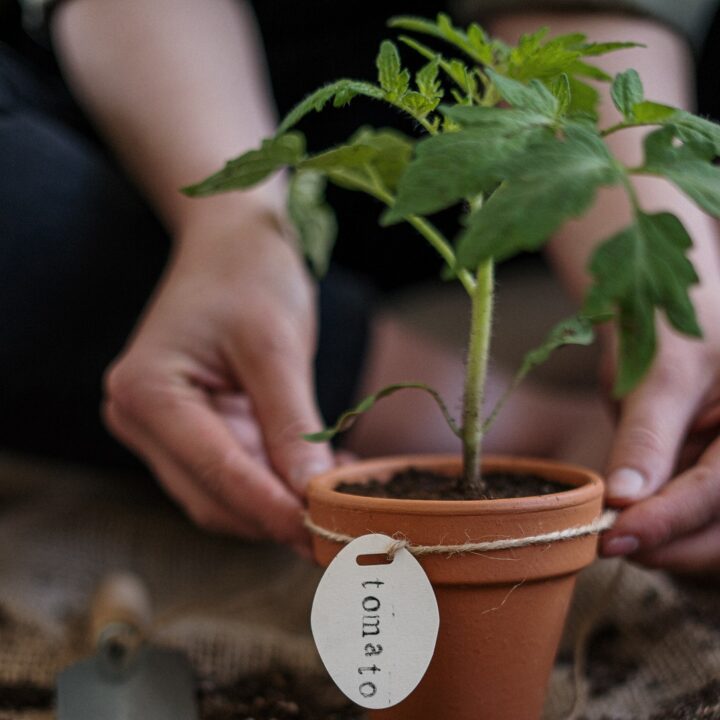Young tomato seedlings will often show signs of nutritional deficiencies in their leaves. If you know what to look for you can remedy it fairly easily and prevent disease, making sure your young plant will grow into a healthy mature plant and give you a bountiful harvest.

Jump to: Prevention During Germination Stage | Yellow Leaves | Purple Leaves | Wilting |Curled Leaves | Stunted Plants
This post may contain affiliate links. As an Amazon Associate, I also earn from qualifying purchases. You can read our disclosure information here–
Whether planting your heirloom tomato in the ground or in a pot, starting off with a healthy seedling is the best way of preventing disease and problems that may plague the plant as the summer goes on.
Here are some key problems you might see at the seedling stage and ways to prevent or resolve them:
Preventing Tomato Seedling Problems
If you are starting your own tomatoes from seed, there are several keys to preventing disease in tomato seedlings:
- Use clean potting soil rather than garden soil. You can purchase high-quality soil from most stores. Miracle Gro Moisture Control is a good one.
- If you start your seedlings in a flat with small cells, or a small container, pot up your plants when they have two sets of true leaves. I go from a 196-cell flat to a 4″ pot to the garden and it has been a successful gradation for over 15 years now. There is not much soil in a small cell, hence the nutrient supply is rapidly depleted from the growing plant, and you need to pot up as you go.
- Carefully control your watering regime. Dryness and water-logging can both make it difficult for plants to take up soil nutrients. I water the seedlings once a day or less, taking my cue from how dry the soil looks (i.e., if the soil is light in color, then water; if it is dark it is still moist and doesn’t need more water).
- I also use an indoor watering hose to water, as you can regulate the amount of water you’re giving the little cells much easier than a watering can with a spout. I’m currently using this small indoor coil hose, as it has a very thin nozzle that you can use to easily regulate the flow of water released onto the small cells.
For more in-depth information on starting plants from seed and getting them off to a good start, see this article on germinating tomato and pepper seeds indoors

Six Common Tomato Seedling Problems
1. Leaves Turning Yellow
Probable Cause: Magnesium deficiency or overfertilizing.
Solution: Decrease the amount of fertilizer you are giving the young plants, as it’s possible you’ve been overdoing it.
If you haven’t given them any fertilizer, the problem could be related to a lack of magnesium. If you suspect this may be the case, you can water the seedlings with a weak solution of Epsom salts.
Over-use of high-potassium fertilizers can cause magnesium deficiency, as plants take up potassium in preference to magnesium.

2. Pale Green Leaves
Probable Cause: Not enough light or a Nitrogen deficiency
Solution: If the seedling is getting plenty of light (16 hours of light/day is good), transplant it to a larger container with fresh potting soil that contains nutrients.
You can also mix some high-quality compost in with your potting soil to ensure a steady nutrient supply.
3. Leaves Turning Purple
Probable cause: Plant is overwatered or has a Potassium deficiency
Solution: If you are not overwatering (see above tips), give the plant a dose of fertilizer that contains trace minerals or transplant to a new medium with a bit of added compost.
If the undersides of the leaves are a reddish purple and the seedling is exhibiting slow or stunted growth, you may be dealing with a phosphorus deficiency due to cold soil or overly acidic soil.
It may be a good idea to transplant the plants to new soil. Make sure to use tepid water when watering, not cold.

4. Leaves are wilting
Probable Cause: Plant is overwatered (root rot) or underwatered
Solution: If it’s quite warm (especially if you are using heating pads under the trays), keep an eye on your seedlings’ soil moisture level. They can dry out quite quickly, especially when they’re still in smaller containers.
Most seedlings will rebound when they receive water if they have not dried out for too long. The bottom leaves may die, but the new growth may survive.
Alternatively, if you find the soil stays wet for a long time, you may be overdoing it. This can cause root rot, making the roots unable to take up enough water and causing leaf wilt as a result.
Root rot is hard to cure and you will probably lose the plant.
5. Curled leaves
Probable Cause: Plant is overwatered or under-watered; pests
Solution: If the leaves on the seedling are curling as well as wilting, that’s a sure sign you either forgot to water or overdid it. Check your watering habits.
They may also have been exposed to too much sun and heat if you are in the process of hardening them off. Remember, baby tomato plants are very fragile.
And while bugs aren’t as likely when starting seeds indoors, they do cause leaf curl as they suck the sap from your plant, so it can’t hurt to check if any are present.
6. Stunted Growth
Probable Cause: The soil is too cold. It also could be a problematic watering regime.
Solution: Surprise surprise, over- or underwatering can also cause stunted growth. It’s really one of the most common causes of tomato seedling problems!
Cold soil and lack of good light can affect baby tomato plants. They’ll hold back on growing until they’re sure they will be able to thrive, so try placing a heat mat underneath the seedling tray and consider supplementing with some artificial lighting.
Graphic Illustration of Plant Nutritional Deficiencies
In many cases, tomato seedling problems are caused by nutritional deficiencies. Plants use up loads of nutrients as they mature and they will suffer without a balanced N-P-K (Nitrogen, Phosphorus, Potassium). Looking at the leaves can often give you some clues as to what’s going on.

If you like my articles about cooking and gardening, subscribe to my weekly newsletter, where I share free recipes and gardening tutorials.
Guides for successfully growing tomatoes
Growing tomatoes is a bit of an art form, but it’s one that you can absolutely learn to master. Have a look at Farm to Jar’s other tomato growing guides to find out everything you need to know about these tasty nightshades, from seed to harvest.


Illustration is exactly what happened to my 50 days tomato plants.
Other pepper, eggplant,are not affected. Porter House from Burpee is not affected.
This is my second year growing large tomato from seeds.
[…] in the weeks after germinating. This is when they are susceptible to root rot and getting leggy. Click here to read about preventing disease in tomato and pepper plants following seed […]
Could I get the author Berry full name and title of book/article – that link goes to a generic Oxford printing page ! Thanks
I’m so sorry Dianne, but their site has changed and I can no longer find the reference. This was a fairly old post that I recently updated, but I didn’t check the links. I’ve removed that section and will do a little more searching the archives to see if I can find the reference. My apologies!
How do you get more leaves/branches on tomato plants? my plants are about 8″ tall with a few leaves on top. I have been pinching them but with little success.
Hi Tina, some of it is variety-specific, but some of it might be in how you are pinching them. Are you pinching off the tops or the suckers? I don’t pinch mine back at all, I just let the suckers make new vines. It sounds like you may have pruned it to be one single vine. Watch for any more suckers and don’t pinch them back. That’s my best guess without knowing a little more anyway.